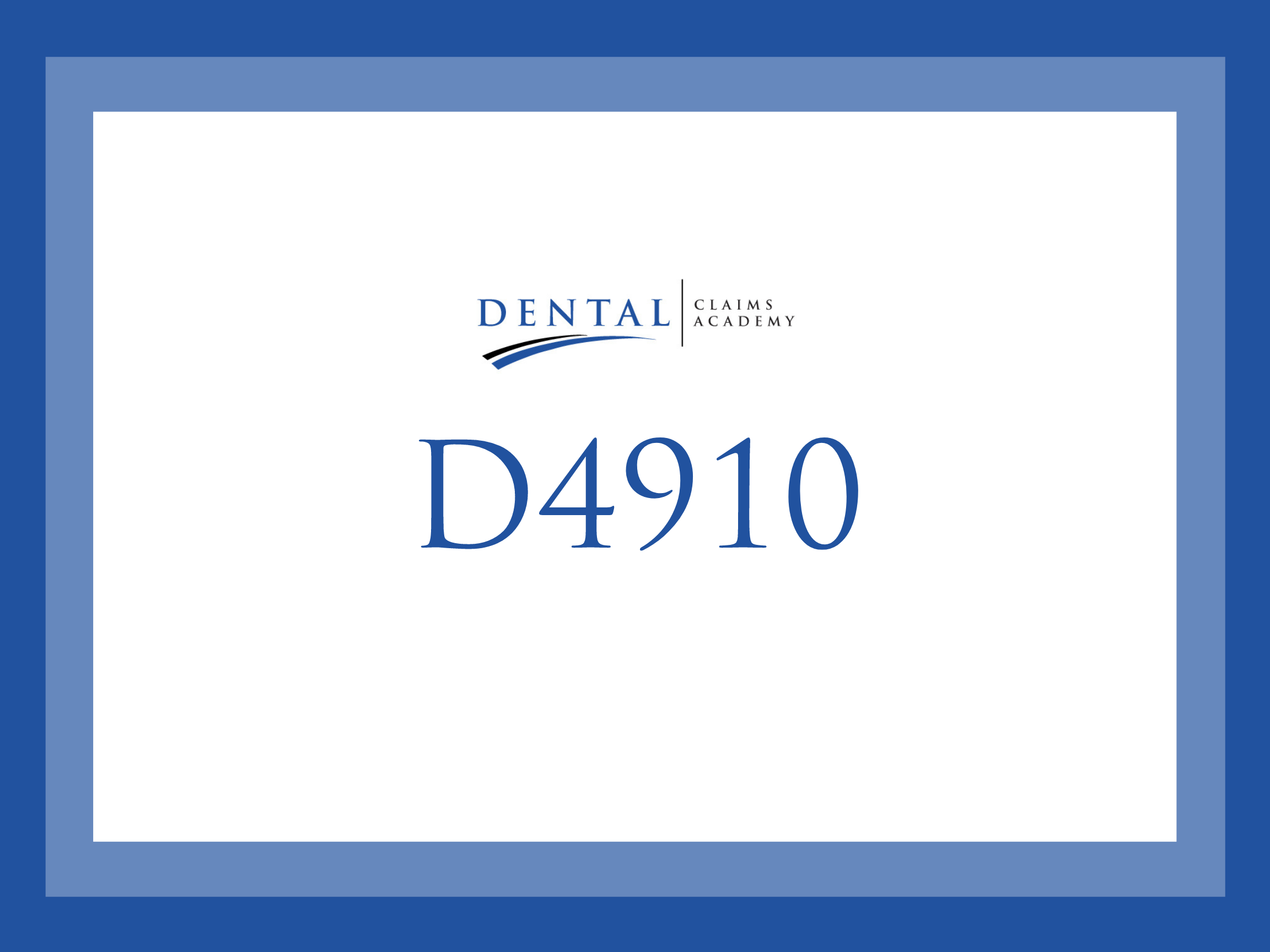CDT code D4910: When should I bill Periodontal Maintenance?


As a dental professional, you're familiar with the periodontal maintenance procedure and CDT code D4910. But applying this code can still be confusing.
The descriptor for D4910 provides clear guidance as to its usage and what is included in the procedure. Some codes contain lengthy, detailed descriptors such as D4910. Practice management software limits the number of characters that can be entered or viewed when selecting the correct code.
Because of this, it's common to not to review the entire code definition.
At Dental ClaimSupport, coding knowledge is highly coveted because of how it affects your claim submission and reimbursement. We've spent the past few years developing Dental Claims Academy to help dental teams stay educated on topics such as CDT coding. Correctly coding dental procedures can affect how much you collect on your insurance claims, and it can affect the compliance of your dental practice.
This article addresses 3 of the most frequently asked questions about CDT code D4910. By going through these questions, you will have a deeper understanding of when to bill periodontal maintenance and when to use CDT code D4910.
What is CDT code D4910?
Let’s first look at the code as a whole.
The code states:
D4910 periodontal maintenance
This procedure is instituted following periodontal therapy and continues at varying intervals, determined by the clinical evaluation of the dentist, for the life of the dentition or any implant replacements. It includes removal of the bacterial plaque and calculus from supragingival and subgingival regions, site specific scaling and root planing where indicated, and polishing the teeth. If new or recurring periodontal disease appears, additional diagnostic and treatment procedures must be considered.

When do I use CDT code D4910?
Below are 3 frequently asked questions in which the D4910 code could be utilized:
- Question 1: My patient had periodontal maintenance (D4910). She returned 1 month later for periodontal scaling and root planing D4342 in one quadrant. Two teeth were treated.
Her insurance was denied with the reason being the localized scaling and root planing is inclusive to the D4910 procedure performed 1 month prior. Why is this the case when the subsequent scaling and root planing was a different treatment?
Answer: A review of the D4910 descriptor states, “It includes…, site-specific scaling and root planing where indicated,…”. Most dental plans have a frequency limitation between any scaling and root planing and periodontal maintenance procedures. The most common frequency is 90 days.
If the patient’s plan frequency limitation is 90 days, then reimbursement will not be made. The charge becomes the patient’s responsibility unless a PPO contract prohibits charging the patient.
Some PPO contracts include a frequency limitation. That frequency PPO provision could deem the service non-billable to the patient. For example, some PPOs require 90 days between any scaling and root planing and D4910, just like dental plans.
If the treatments do not meet this requirement, it can be a write-off for the practice. Refer to your PPO processing policy manuals for clarity on such provisions.
- Question 2: I received a denial for D4910 due to frequency. How can I appeal this? My patient is seen for periodontal maintenance 4 times a year. His dental plan allows 2 periodontal maintenance procedures and 2 prophylaxis procedures per calendar year.
Answer: First, review the clinical documentation. The documentation should indicate that a prophylaxis was performed as part of the D4910 procedure. Per the descriptor, D4910 includes “…removal of the bacterial plaque and calculus from supragingival and subgingival regions, and polishing the teeth”.
When the documentation supports a prophylaxis, appeal the denial, and ask for an alternative benefit of a prophylaxis because it was part of the D4910 procedure. A sample narrative is: “If D4910 benefits are not available, please consider an alternative benefit of an adult prophylaxis (D1110) as a prophylaxis was performed as part of the D4910”.
- Question 3: A denial for D4910 was received for my patient stating no history of periodontal therapy on file. This patient has been receiving periodontal maintenance for 5 years.
She just changed jobs and has a new insurance. Her insurance states that she must have a history of scaling and root planing within the previous 36 months. How can this denial be appealed?
Answer: Appeal. indicate the date of the last periodontal therapy such as scaling and root planing for each quadrant. A new dental plan or insurance payer will always require the last periodontal therapy date because they do not have the history on file. D4910 is indicated following active periodontal therapy, per the descriptor.
Also, include historical complete periodontal charting and probing. The narrative should have dates of D4910 and documentation of any site-specific scaling and root planing performed as part of the D4910 visits.
The clinical documentation must be specific to the teeth numbers and sites where scaling and root planing was performed during the D4910 visit. Without specificity in documentation, chances of winning this type of appeal are not likely.

Ready to feel more confident when coding?
Documentation is critical in each of the three examples discussed in this article. Specificity in the clinical notes is a must for all procedures. The lack of details of what was performed and why it was performed is an ongoing problem for most dental teams. Consider holding random chart audits in your practice as a team.
Use the results of your internal audit to learn and improve your documentation. Some payers will not accept a narrative, only the chart note for the referenced date of service. Thoroughness in documentation is not about reimbursement as much as proving quality patient care and medical necessity.
Dental Claims Academy is a resource for dental professionals who wish to feel empowered when handling their coding and billing. The educational platform offers courses covering all kinds of topics, such as CDT coding, documentation, and billing best practices.
Enroll your team in Dental Claims Academy on our website, and feel empowered next time you have to handle CDT coding.
Related Posts
Dental revenue resources from Dental Claim Support

